
2024 Yamaha MT-09 Y-AMT: Is the Automatic Gearbox Worth It?
Overall Rating: 4/5
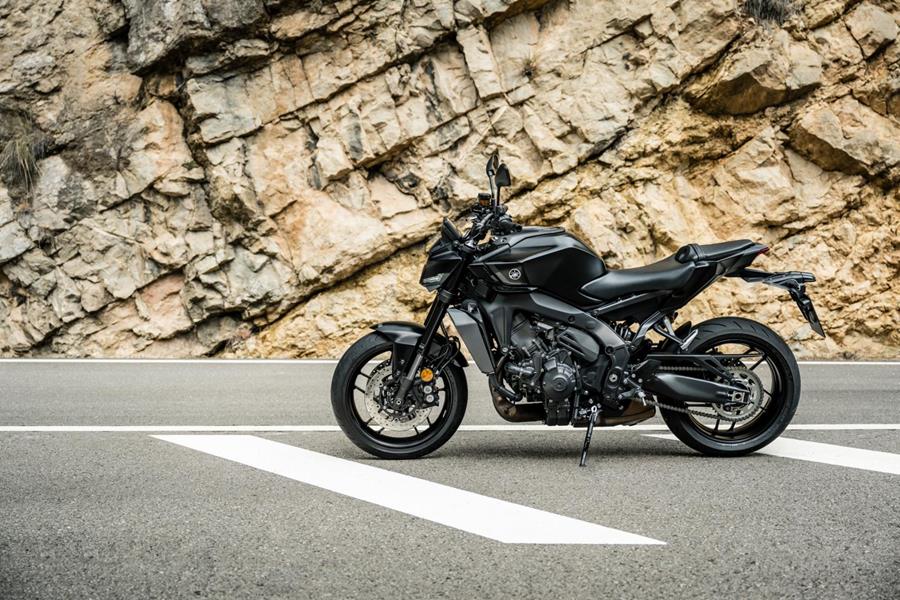
Yamaha MT-09 Y-AMT: A Fusion of Sportbike and Automatic Convenience
Yamaha's MT-09 Y-AMT introduces a semi-automatic transmission system that aims to bridge the gap between traditional sportbikes and the comfort of automatic transmissions.
Y-AMT: How it Works
The Y-AMT system utilizes a sophisticated clutch and gear-shifting mechanism, effectively eliminating the need for a clutch lever and manual gear shifting. It offers two distinct modes:
- Fully Automatic Mode: The system automatically selects the optimal gear based on throttle input, engine speed, and vehicle speed. This mode prioritizes seamless and effortless riding, making it ideal for urban commuting or long rides.
- Manual Mode: Riders can manually shift gears using paddle shifters mounted on the left handlebar. This allows for more control and engagement, especially during sporty riding.
Key Takeaways
- Pros: Eliminates clutch lever and gear shifter; Offers smooth and effortless automatic shifting; Provides manual control via paddle shifters; Enhanced rider comfort, especially in stop-and-go traffic.
- Cons: May exhibit occasional shifting delays or hesitation, particularly under heavy acceleration. Important Note: The Y-AMT system is not a fully-fledged automatic transmission like those found in cars, as it still requires the rider to engage the starter button for each start.
Comparison with Similar Technologies
Compared to other manufacturers' automatic or semi-automatic motorcycle transmissions, the Y-AMT system offers a unique blend of sportbike performance and automatic convenience. While other systems may offer faster shifting times, the Y-AMT focuses on providing a smooth and intuitive experience.
Real-World Applications
The MT-09 Y-AMT is ideal for riders who seek the thrill of a sportbike with the convenience of an automatic transmission. It's perfect for those who prefer effortless riding or those who find traditional clutch lever operation challenging.
Automatic vs. Manual
Automatic vs. Manual Transmission: A Driver's Perspective
This car's automatic transmission, even in its sportier 'D+' setting, exhibits some unpredictability in shift timing. While this might be suitable for urban driving, where smooth transitions are paramount, it might not be ideal for more spirited driving on open roads. The automatic mode prioritizes fuel efficiency and smooth driving, but this can sometimes translate to less responsive acceleration when the driver desires a more aggressive driving experience.
Manual Mode for Enthusiasts
In contrast, the manual mode offers a more engaging and responsive driving experience. The well-placed gearshift paddles allow for precise and immediate gear changes, enhancing the driver's control over the vehicle's performance. This manual control provides a thrilling and immersive driving experience, allowing drivers to truly connect with the car's power and dynamics. The manual mode feels more like a video game, where the driver is actively involved in the driving experience.
Key Takeaways
-
Automatic Mode:
- Prioritizes smooth and efficient driving.
- Ideal for urban driving conditions.
- May feel sluggish or less responsive during spirited driving.
-
Manual Mode:
- Provides a more engaging and responsive driving experience.
- Ideal for drivers who enjoy the thrill of manual control.
- Allows for precise and immediate gear changes.
Real-World Applications
The availability of both automatic and manual transmission modes provides flexibility for different driving styles and preferences. Drivers who prioritize smooth and efficient driving can opt for automatic mode, while those seeking a more exhilarating driving experience can utilize the manual mode. This caters to a wider range of drivers, ensuring that everyone can enjoy the car's unique character.
MT-09 Evolution
Evolution of the Yamaha MT-09
The Yamaha MT-09, a popular naked sportbike, has undergone significant transformations since its debut in 2013. The initial model, while praised for its thrilling 847cc triple-cylinder engine, faced criticism for its handling and suspension.
2021: A Major Upgrade
Yamaha addressed these shortcomings in the 2021 model year. Key improvements included:
- Revised Chassis: A new, lighter frame with revised geometry for sharper handling.
- Upgraded Suspension: A fully adjustable KYB fork and rear shock for improved ride quality and control.
- Enhanced Electronics: A new 6-axis IMU (Inertial Measurement Unit) for enhanced traction control and wheelie control.
These upgrades brought the MT-09 closer to the traditional definition of a sporty naked bike, offering both thrilling performance and improved handling.
2024: Further Refinement
For 2024, Yamaha continued to refine the MT-09's overall riding experience.
- Ergonomics: The riding position was further tweaked for improved comfort and control.
- Suspension Tuning: The suspension setup was fine-tuned for even better handling and ride quality.
Key Takeaways:
- The 2024 Yamaha MT-09 represents the culmination of continuous development, offering a well-rounded package for both everyday riding and track day fun.
- The bike's combination of powerful engine, improved handling, and advanced electronics has led to critical acclaim and rider satisfaction.
Important Notes:
- Technical Specifications: The 2024 MT-09 features the Yamaha CP3 engine, producing 117 horsepower and 68.6 lb-ft of torque. The bike weighs in at 427 lbs wet.
- Comparison: The MT-09 faces stiff competition from other popular naked sportbikes like the Triumph Street Triple, KTM Duke 890, and Ducati Monster. However, the MT-09's combination of performance, value, and versatility makes it a compelling choice for riders seeking a well-rounded package.
Ride and Handling
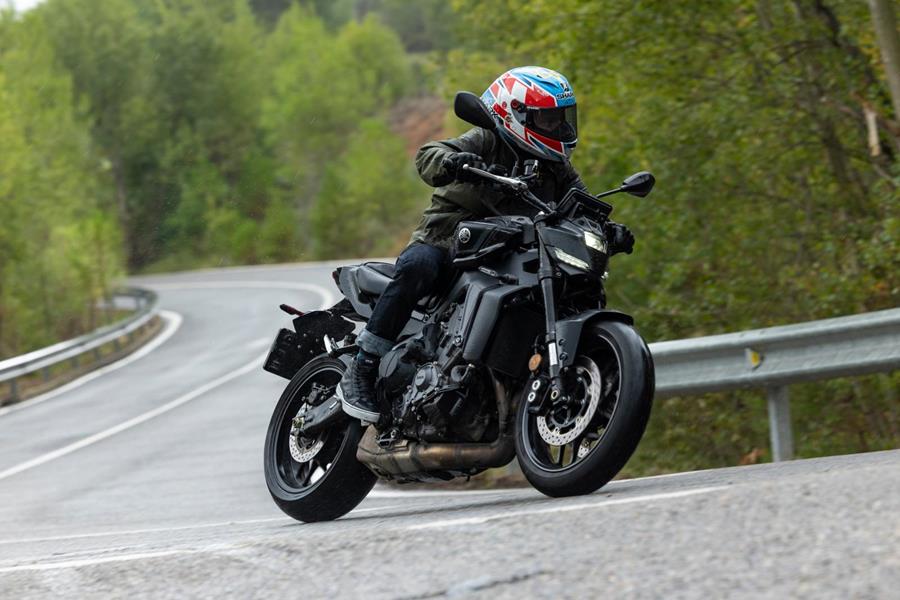
Enhanced Performance with Y-AMT System
The Y-AMT (Yamaha Advanced Motorcycle Technology) system, while adding a mere 3 kg to the overall weight of the MT-09, delivers a significant upgrade to its performance and riding experience.
Weight Distribution and Handling
- The system's careful integration ensures minimal impact on the bike's overall weight balance.
- The revised geometry and suspension settings, fine-tuned for optimal performance, contribute to a noticeably more responsive and engaging ride.
- This translates to a more precise and confident handling experience, particularly during cornering and aggressive maneuvers.
Thrilling Performance
"The engine remains the heart of the bike, providing a thrilling and versatile experience." - Original Paragraph
The MT-09's 890cc triple-cylinder engine, renowned for its thrilling power delivery, is further enhanced by the Y-AMT system. It seamlessly connects the rider's intentions to the road, allowing for both powerful acceleration and precise throttle control.
Practical Implications
- The Y-AMT system makes the MT-09 more accessible to a wider range of riders, including those new to sport bikes.
- It enhances the overall riding experience, allowing riders to fully immerse themselves in the dynamic performance of the bike.
Key Takeaways
- The Y-AMT system is a lightweight addition that delivers significant performance enhancements.
- The revised geometry optimizes handling, leading to a more engaging ride overall.
- The Y-AMT system broadens the appeal of the MT-09 by making it more rider-friendly without compromising its thrilling engine performance.
Engine Powerhouse
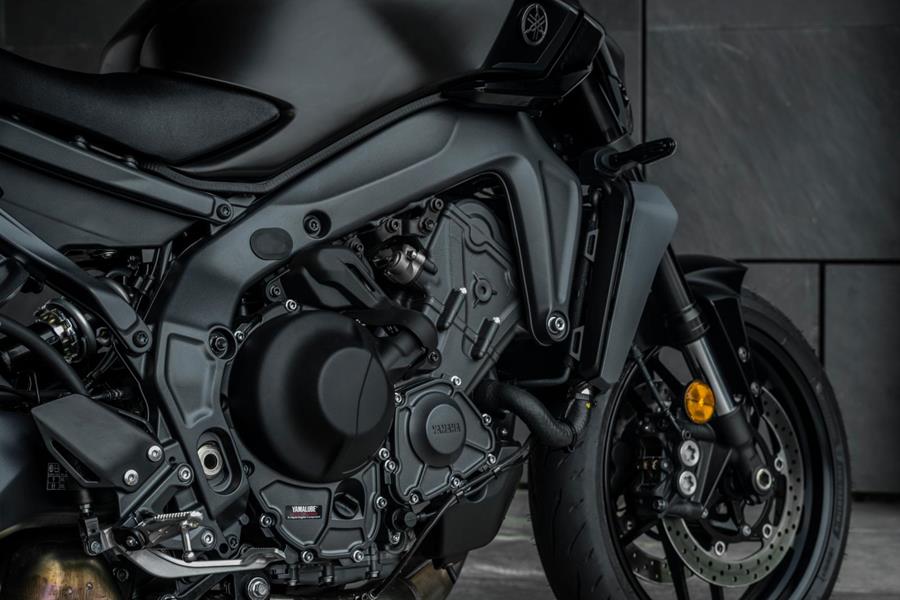
Yamaha MT-09: A Powerful Engine with Seamless Transmission
The Yamaha MT-09's CP3 engine is a 847cc, 3-cylinder unit that delivers impressive performance in the sub-litre motorcycle category.
Engine Specifications:
- Displacement: 847cc
- Type: Liquid-cooled, 4-stroke, DOHC, 3-cylinder
- Power: 115 hp @ 10,000 rpm
- Torque: 87.5 Nm @ 8,500 rpm
Key Takeaways:
The CP3 engine's design emphasizes torque production, making it feel lively and responsive from low RPMs. This characteristic makes it ideal for both casual cruising and aggressive riding.
Y-AMT Transmission:
The Y-AMT (Yamaha Advanced Manual Transmission) offers the seamlessness of an automatic with the control of a manual. It allows for smooth gear changes without the need for a clutch lever, making it effortless to ride in urban environments or on long journeys.
Pros:
* Ease of Use: Eliminates the need for clutch operation, making riding smoother and more relaxing.
* Improved Performance: Offers quicker and more precise shifts for enhanced acceleration and control.
* Enhanced Fuel Efficiency: Optimized gear ratios and automatic shifting contribute to better fuel economy.
Cons:
* Cost: The Y-AMT system adds cost compared to a standard manual transmission.
* Limited Customization: The automatic nature of the system reduces rider control over gear changes.
Real-World Applications:
The combination of the CP3 engine and the Y-AMT system makes the MT-09 a versatile motorcycle. Its powerful engine provides thrilling acceleration, while the seamless transmission allows for effortless riding in diverse settings – from city streets to winding roads.
Y-AMT Performance
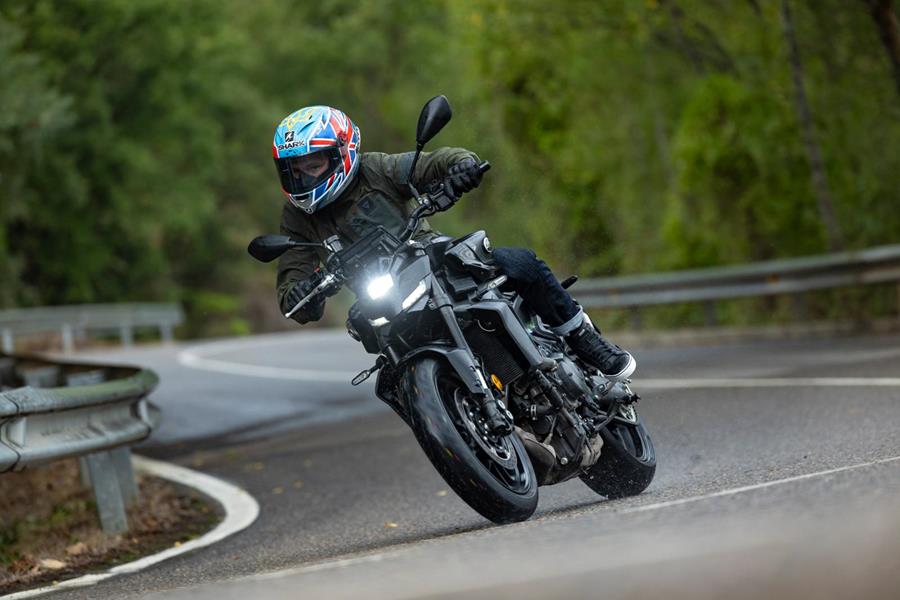
Y-AMT System: Manual vs. Automatic Modes
The Y-AMT system offers a unique driving experience with its distinct manual and automatic modes.
Manual Mode: Thrilling Responsiveness
- Paddle Shifters: The system utilizes paddle shifters for manual gear changes, providing a direct and engaging connection with the transmission.
- Enhanced Control: This manual mode offers a high level of control, allowing drivers to precisely select gears for optimal performance and driver input.
- Thrilling Experience: The responsiveness of the paddle shifters delivers a thrilling and immersive driving experience.
Automatic Mode: Smoothness with Trade-offs
- Smooth Operation: The automatic mode provides a smooth and effortless driving experience, particularly in everyday driving scenarios.
- Potential Sluggishness: While smooth, the automatic mode can sometimes be sluggish in situations requiring quick acceleration or downshifts.
- IMU Integration: The Y-AMT system's lack of integration with the Inertial Measurement Unit (IMU) can lead to gear changes at lean angles, particularly during cornering. This can create a disconcerting sensation for the driver.
Key Takeaways
- Manual Mode: Offers a highly engaging and responsive driving experience.
- Automatic Mode: Provides smoothness but may exhibit occasional sluggishness and lack IMU integration.
Practical Implications:
- Sporty Driving: The manual mode is ideal for enthusiastic drivers who value control and responsiveness.
- Everyday Driving: The automatic mode is better suited for everyday commutes and relaxed driving.
- Track Performance: The lack of IMU integration can be a drawback on racetracks, where precise gear changes at lean angles are crucial.
Comparison with Similar Technologies:
- Dual-Clutch Transmissions (DCT): DCTs are known for their lightning-fast gear changes and responsiveness, but often lack the tactile feel of a manual transmission.
- Traditional Automatic Transmissions (AT): ATs are generally smooth and efficient but can sometimes be slower to react compared to DCTs or manual transmissions.
Reliability and Build Quality
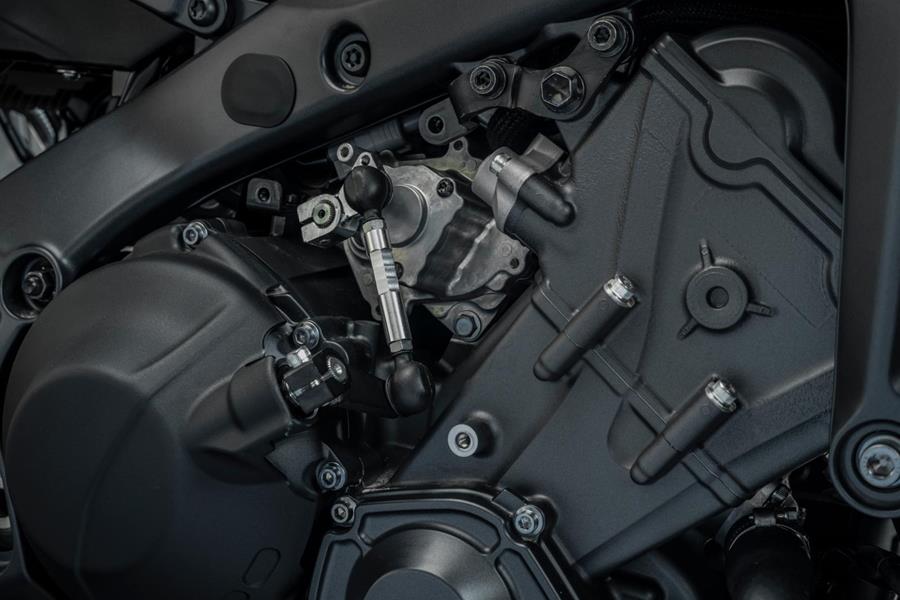
Yamaha's CP3 Engine: A Proven Performer
The CP3 engine platform, a cornerstone of Yamaha's motorcycle lineup, boasts a robust reputation for reliability. This engine family, characterized by its smooth power delivery and fuel efficiency, powers a diverse range of Yamaha models, including the popular MT-07 and Tracer 7. Its widespread adoption and minimal reported issues contribute to its strong track record.
Y-AMT: A New Era of Transmission Technology
Yamaha's Y-AMT (Yamaha Advanced Manual Transmission) system marks a significant advancement in motorcycle transmission technology. This innovative system, essentially a sophisticated clutchless manual gearbox, offers seamless gear shifts while retaining the engaging feel of a manual transmission.
Technical Specifications
- Shifting Mechanism: Electrically actuated clutch and automated gearbox
- Gear Selection: Manual (rider control) or automatic (computer-controlled) modes
- Benefits: Effortless shifting, improved rider comfort, potential performance gains
Key Takeaways
- Improved Rider Experience: Y-AMT simplifies gear changes, allowing riders to focus on the road ahead.
- Enhanced Performance: The system offers smooth, precise shifts, potentially contributing to faster acceleration and improved lap times.
- Future Potential: Y-AMT has the potential to evolve further, incorporating features like adaptive shifting, which anticipates rider input and adjusts gear selection accordingly.
Comparison: Y-AMT vs. Traditional Transmissions
| Feature | Traditional Manual | Y-AMT |
|---|---|---|
| Shifting | Manual | Automated (with manual override) |
| Clutch Control | Rider-operated | Automated |
| Complexity | Simpler | More complex |
While the Y-AMT system is relatively new, its advanced design and Yamaha's commitment to quality suggest that it will inherit the reliability of its predecessor engine platforms. This combination of a proven engine and a cutting-edge transmission platform sets the stage for a new era of performance and rider comfort in Yamaha's motorcycle lineup.
Value and Rivals
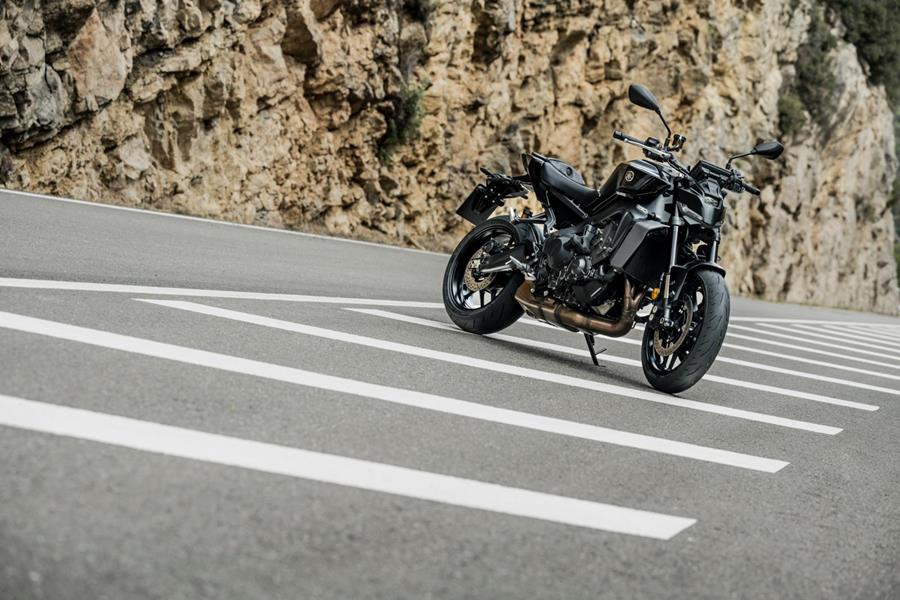
Yamaha MT-09 with Y-AMT: A Unique Offering
The Yamaha MT-09, known for its spirited performance and affordability, offers a compelling option for riders seeking a semi-automatic transmission. While the standard MT-09 shines in its class, the inclusion of Yamaha's Y-AMT (Yamaha Automatic Manual Transmission) presents a distinct advantage, setting it apart from rivals.
Y-AMT: Key Features
- Seamless Gear Changes: The Y-AMT system utilizes a traditional clutch and gearbox, but with automated shifting for effortless transitions between gears.
- Up/Down Shifting: The system offers both up and down shifting capabilities, allowing for both relaxed cruising and spirited riding.
- Manual Control: Riders retain full manual control through the handlebar-mounted shift paddles, enabling them to take charge when desired.
- Adaptive Shifting: The system's intelligent algorithms adjust shift points based on rider input and engine load, ensuring optimal performance.
Cost and Comparison
The Y-AMT adds £550 to the standard MT-09's price. While this premium positions the Y-AMT competitively against other semi-automatic systems like Honda's DCT (Dual Clutch Transmission) and Kawasaki's E-Clutch, it differs in its mechanical implementation. The DCT and E-Clutch systems utilize two separate clutches for smoother, faster shifts. The Y-AMT, however, retains the traditional single-clutch design, offering a more affordable alternative.
Practical Implications
- Enhanced Comfort: The Y-AMT eliminates the need for constant clutch engagement and shifting, offering a more relaxed riding experience, especially in traffic.
- Sharper Performance: Precise and controlled shifts, especially on downshifts, enhance the overall riding experience.
- Improved Focus: By automating the shifting process, the Y-AMT allows riders to focus on other aspects of riding, such as line selection and cornering.
Important Note: The Y-AMT system, despite offering significant benefits, may not be ideal for riders who prefer the raw, mechanical engagement of a manual transmission.
Equipment
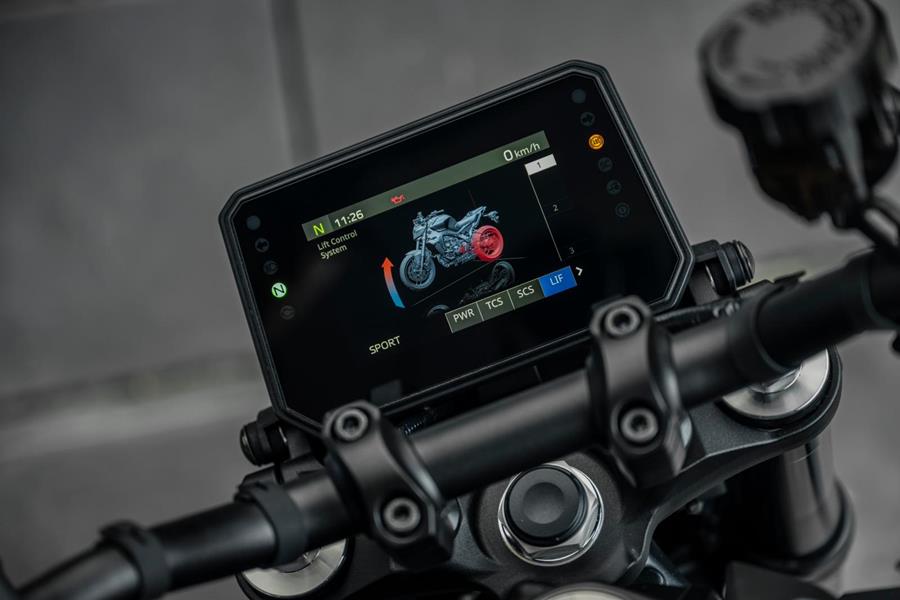
Advanced Rider Aids:
The Yamaha MT-09 Y-AMT boasts a comprehensive suite of rider aids powered by a sophisticated six-axis Inertial Measurement Unit (IMU). This technology senses the bike's orientation and movement in three dimensions, providing precise data for various electronic systems.
- Traction Control: This system monitors wheel slip and adjusts engine power to prevent loss of traction, enhancing stability and control, especially on slippery surfaces.
- Anti-lock Braking System (ABS): ABS prevents wheel lock-up during braking, ensuring optimal stopping power and stability. It features a sophisticated algorithm that constantly monitors wheel speed, applying appropriate brake pressure to maintain control.
- Wheelie Control: This feature prevents excessive wheelies by controlling engine power and throttle response, allowing riders to accelerate aggressively while maintaining stability.
- Rider Modes: The MT-09 Y-AMT offers multiple rider modes, each with specific settings for throttle response, traction control, and ABS intervention. This allows riders to tailor the bike’s behavior to suit their preferences or riding conditions.
Connectivity and Display:
The Yamaha MT-09 Y-AMT features a 5-inch full-color TFT dash that provides clear and concise information to the rider.
- Connectivity: The dash includes standard connectivity features, allowing riders to pair their smartphones for navigation, music, and calls.
- Customizable Display: Riders can customize the display to show various data points, including speed, RPM, gear position, fuel level, and more.
Key Takeaways:
* The MT-09 Y-AMT's rider aids and connectivity features offer a sophisticated and enjoyable riding experience.
* The six-axis IMU provides precise data for the electronic systems, enhancing safety and control.
* The TFT dash offers a highly informative and customizable interface.
Practical Implications:
* Enhanced Safety: The rider aids significantly improve safety by assisting riders in maintaining control in various situations.
* Improved Performance: The electronic systems allow riders to push the bike’s limits while maintaining confidence and control.
* Enhanced User Experience: The connectivity and customization features provide a more enjoyable and personalized riding experience.